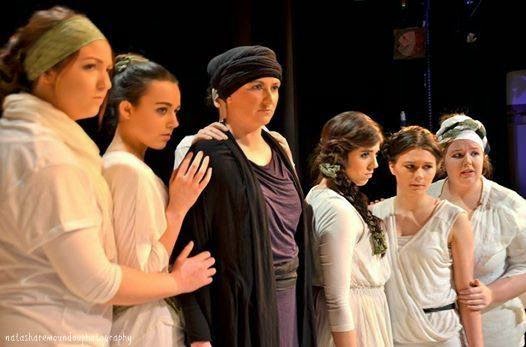We knew from the beginning that we didn't want to try to recreate the conditions of ancient Greek theatre, though we would inevitably be inspired by and respond directly to the performance conventions of the work. Given that we were working with an adaptation by Frank McGuinness, we also wanted to respond directly to our immediate Irish context but did not want to stage an "Irish" production in the sense of making the whole world fit with immediately recognisable conventions of Irish theatre.
What resonated with us immediately was the role of natural elements in the world: earth, stone, air, fire, water.
We became interested by resonances between the natural landscapes of Greece and the West of Ireland, and our immediate location became more important to us in thinking through the aesthetics of the design. For example, we were struck by how the West of Ireland's topography sometimes took on the rough shape of a Greek theatre space.
The Burren became particularly important to us. The cracks of the rocks reminded us of the fractures and intransigent positions of the family of the House of Atreus, who never quite let go of the past and remain forever broken by it.
The most important element to us in the play besides earth was water. I was particularly haunted by an image of Clytemnestra, Electra's mother, walking beside the ocean at night, and mourning the death of her other daughter, Iphigenia, at the hands of her husband, Agamemnon. This murder (or sacrifice depending on who you speak to) occurred to ensure the safe passage of Agamemnon's army across the sea to Troy during the Trojan War. But it is this act which spurred Clytemnestra's murder of her husband, and the retributive actions of Electra and her brother Orestes in our play. I always have a soft spot for those hated or marginalised in history, so I sympathise deeply with Clytemnestra's position as a mourning mother.
But within the sea, we also began to find a broader emotional and colour vocabulary for the production. We began to think about the phases of the sea and its moods as the colour palette for lighting and costume as you will see in posts from our lighting and costume designers (Jack Scullion, Maria Tivnan and Dawn Monahan). From deep inky night, to sparkling morning waters, from calm to turmoil, from roar to whisper, we began to see and hear the production in a new way. Sound design at this point also entered the conversation, an area to be expanded upon in later posts by Conor McBrierty, our sound designer, as well as the ensemble as a whole.
By the end of our first week of rehearsal last week then, we had found a line in the script that brought together the essence of these earlier conversations and confirmed our continually developing intuitions.
The Chorus tells us "She waits for her glory until stone turns to water." The battle between remaining stuck in the past and moving forward on a more dynamic path ground the heart of this play.
The struggle between these natural elements is at the centre of what we see in the text and consequently, what we are designing and what we are staging. This vision continues to deepen, but it is both our starting point and continuing journey at this time.
Charlotte McIvor, Lecturer in Drama and Electra Director



No comments:
Post a Comment